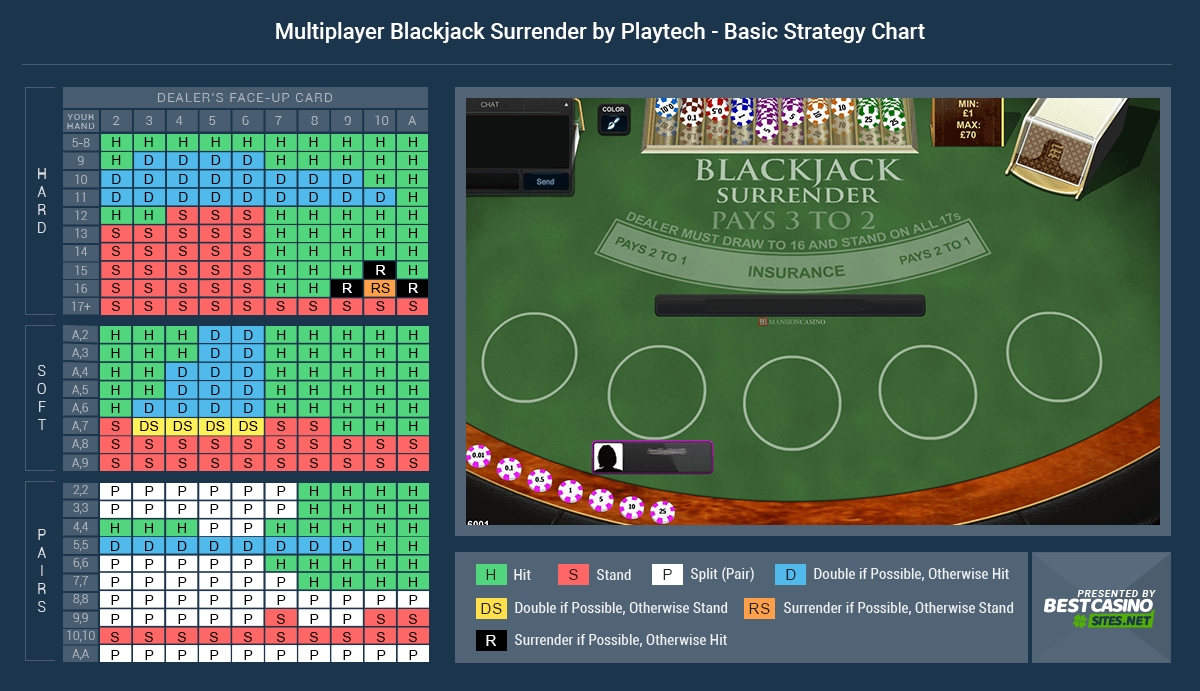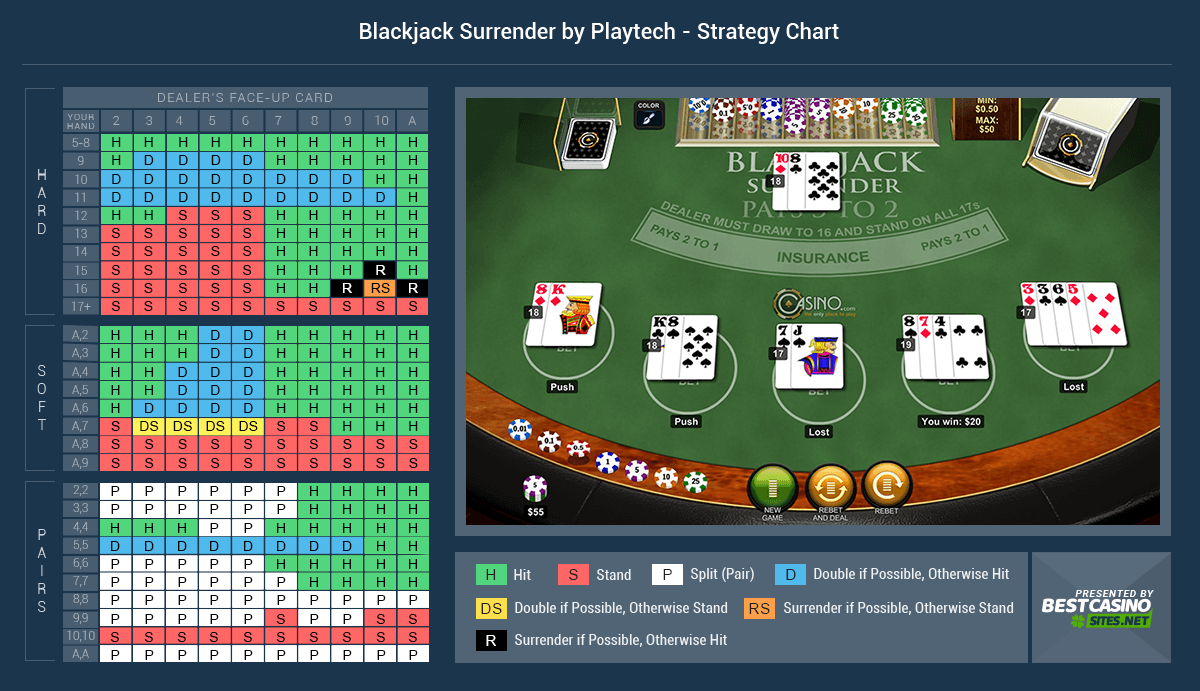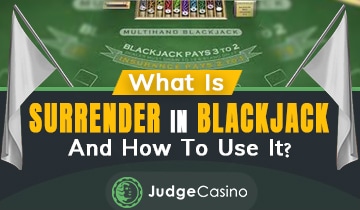Does the concept of the surrender rule in blackjack confuse you?
- Blackjack Surrender Online
- Blackjack Surrender Chart
- How To Surrender Blackjack
- Blackjack Surrender House Edge
- Blackjack Surrender Hand Signal
You're not alone.
We think this is the least-understood rule in blackjack. The difference between early surrender and late surrender is important. Improving your understanding of blackjack surrender rules means improving your overall game strategy.
Some blackjack games allow players the option of giving up (or 'surrendering') their hands right after the initial deal is complete, for the cost of half of their ante bet. The idea is to quit while you're ahead if you feel like you don't have a shot at winning the hand. Surrender rules are an advantage for the player, in that she can choose to keep half of her original bet rather than play out her hand and lose the entire thing.
The surrender option in blackjack gives players the opportunity to give up their hand and receive half of their bet back. This can be done both online and in brick-and-mortar casinos. Online, it is done by clicking the corresponding button, while at land-based casinos, players need to make the appropriate hand gesture. The surrender rule is a good deal for the blackjack player, but is hard to find at brick and mortar casinos nowadays. Casino Tropez offers this favorable rule at their online casino which cuts the house edge to a low 0.39%. If you're looking to play longer and win more, be sure to try the blackjack surrender table! Play Now at Casino Tropez! No surrender, Early Surrender or Late Surrender Blackjack games will either not offer the option ('no surrender'), or offer the option at specific moments in the game. You will be able to surrender if the dealer has an Ace as his upcard. If he does, there are chances that he may have a blackjack.
Blackjack surrenders come in two flavors: early and late.
To use the surrender rule to your advantage, it's important to understand the differences between the two types of surrender.
What Is Early Surrender?
An early surrender is when the player chooses to give up on their hand immediately after the cards are dealt but before the dealer checks for a natural blackjack. The early surrender requires that players forfeit half their original wager.
The early surrender rule is the most desirable type of surrender because it's available regardless of whether or not the dealer was dealt a natural. As is often the case with rules that favor the player, the early surrender rule is rare these days.
Why has the early surrender disappeared?
According to the Wizard of Odds, the addition of an early surrender rules cuts into the casino's built-in edge by 0.63%. To put that in perspective, changing a game's shoe from eight decks to one affects the house edge less (+0.59%) than the addition of an early surrender rule.
This doesn't means that casinos won't offer early surrender – some do–especially online casinos.
But they compensate with other rule changes that chisel away at the advantage you gain from the early surrender rule.
What Is Late Surrender?
The late surrender rule allows a player to give up on their hand for the cost of half their ante, just like an early surrender.
But unlike an early surrender, this rule requires that you wait to see if the dealer has been dealt a natural blackjack first. If the dealer did catch a natural, you can't surrender, and you'll lose your whole wager just like if you never chose the surrender option in the first place.
Late surrender rules don't lower the casino's edge anywhere near the amount that early surrender rules do.
According to the same source at Wizard of Odds, a late surrender rule cuts into the casino's edge by about 0.1%–about as much as a Doubling rule. As a consequence of its smaller negative impact on the casino's bottom line, you're more likely to see this form of the surrender rule than the early version.
Even though the reduction in the house edge is small, it's an advantage that's worth seeking out.
A note on blackjack etiquette and surrender rules – it's common for land-based casinos to offer a late surrender without advertising it. You should always ask your dealer if there's a late surrender option. Even though the player advantage is small, the casino isn't in the business of giving any amount of money away.
The Difference Between Early & Late Surrender
The difference between the two is simple – early surrender rules allow you to give up your hand for half your wager even if the dealer holds a natural blackjack, while late surrender rules allow you to give up half your wager only if the dealer doesn't hold a natural.
Surrender Strategy
The strategy for games with early surrender and games with late surrender rules is different enough that even the ideal playing styles are different. Here's a basic guide to the proper ways to play for both early and late surrender blackjack games.
When You Should Take an Early Surrender
Though the early surrender is a tempting move when you find a table that offers it, we only recommend you consider abandoning your wager in the following three situations:

- When the dealer shows Ace and you hold a hard total of 5 – 7 or 12 – 17.
You should hit on hard totals between 8 and 11, but up against an Ace the early surrender rule gives you the best possible return on pretty much every other hard hand.
- When the dealer shows Ace and you hold 33, 66, 77, or 88.
These are all acceptable split hands in other situations but against a soft dealer hand, an early surrender is the acceptable play here.
- When the dealer shows any 10 and you hold a hard total of 14-16.
If you draw is anything about 5-7, you're bust. Unless you're keeping a stellar count, you're in dangerous territory, and the early surrender will help you cut your losses.
When You Should Take a Late Surrender
Once again, the late surrender option may be appealing in plenty of game situations, but we only think it is strategically-feasible in the following three:
- When the dealer shows Ace and you hold any total of 15.
The only exception here is that you don't surrender if the game's rules indicate that the dealer must hit a soft 17.
- When the dealer shows Ace or any 10 and you hold any total of 16.
This rule is true regardless of the game's rules regarding how the dealer behaves on a total of 17.

- When the dealer shows Ace and you hold any total of 17.
If you're playing in a game in which the dealer is forced to hit a soft 17, ignore this rule.
When You Should Refuse a Late Surrender
Here are a couple of common mistakes blackjack players make with the late surrender rule:
- You should NOT take a late surrender when the dealer stands on soft 17 while showing a 9, 10, or Ace while you hold any total of 15 or 17.
This is one of those rules you just have to memorize at first until it starts to make sense to you at the table.
- You should NOT take a late surrender when the dealer shows a 9 and you hold any total of 16.
This is simple mathematics. The dealer is more likely to come in underneath your point total than you are to bust out by taking a hit.
SummaryAnyone who's played a round or two of blackjack in the casino appreciates the appeal of the surrender rule. Sometimes it's best to accept the loss of half your ante and hope for a better deal.The most obvious example is 16, the worst garbage hand in the game.
Holding a 16 looks even worse when the dealer is showing a 10.
This is just one example of a time when you're obviously better off giving up half the ante and moving past the terrible deal. If you think of this move as getting back half of a bet you would have lost, you see the beauty of the blackjack surrender rule.
- Appendices
- Miscellaneous
- External Links
On This Page
Introduction
What is surrender in blackjack? This is a strategy in which the player may fold the hand risking only half of the bet rather than the entire amount. There are two options in terms of surrendering your hand. Late Surrender may be done after the dealer checks for blackjack and Early Surrender is possible before the dealer check. This page takes an in-depth look at the choice to surrender in blackjack. It depends on lots of things, whether the dealer takes a hole card, the number of decks, whether the dealer hits or stands on soft 17, and sometimes the composition of the player's hand.

The purpose of this page is to give exact advice to the basic-strategy player on when to surrender. When the tales show a total of 16, this refers to either a 10+6 or 9+7 total. The situation of two eights has a separate row when surrender is appropriate.
Late Surrender

Late surrender means that the player may surrender his hand and lose half his bet only after the dealer checks for blackjack. The following basic strategy tables show when to surrender (Y=yes, N=no) depending on the player's total, dealer's up card, and the number of decks. The right two columns represent a dealer ace according to whether the dealer stands (S17) or hits (H17) a soft 17.
Late Surrender — One Deck — Total Dependent
| Player's Hand | Dealer's Card | |||
| __9__ | __10__ | A (S17) | A (H17) | |
| 15 | N | N | N | Y |
| 16 | N | Y | Y | Y |
| 17 | N | N | N | Y |
Late Surrender — Two Decks — Total Dependent
| Player's Hand | Dealer's Card | |||
| __9__ | __10__ | A (S17) | A (H17) | |
| 15 | N | Y | N | Y |
| 16 | N | Y | Y | Y |
| 17 | N | N | N | Y |
Late Surrender — Four or More Decks — Total Dependent
| Player's Hand | Dealer's Card | |||
| __9__ | __10__ | A (S17) | A (H17) | |
| 15 | N | Y | N | Y |
| 16 | Y | Y | Y | Y |
| 17 | N | N | N | Y |
The exact card composition of the player's hand can sometimes make it advantageous to deviate from the basic strategy tables above. The following tables show when exactly to surrender given the player's total, dealer's up card, and number of decks. If the dealer has an ace up then the strategy often depends on whether the dealer hits (H17) or stands (S17) on a soft 17.
One Deck — Late Surrender — Composition Dependent

- When the dealer shows Ace and you hold a hard total of 5 – 7 or 12 – 17.
You should hit on hard totals between 8 and 11, but up against an Ace the early surrender rule gives you the best possible return on pretty much every other hard hand.
- When the dealer shows Ace and you hold 33, 66, 77, or 88.
These are all acceptable split hands in other situations but against a soft dealer hand, an early surrender is the acceptable play here.
- When the dealer shows any 10 and you hold a hard total of 14-16.
If you draw is anything about 5-7, you're bust. Unless you're keeping a stellar count, you're in dangerous territory, and the early surrender will help you cut your losses.
When You Should Take a Late Surrender
Once again, the late surrender option may be appealing in plenty of game situations, but we only think it is strategically-feasible in the following three:
- When the dealer shows Ace and you hold any total of 15.
The only exception here is that you don't surrender if the game's rules indicate that the dealer must hit a soft 17.
- When the dealer shows Ace or any 10 and you hold any total of 16.
This rule is true regardless of the game's rules regarding how the dealer behaves on a total of 17.
- When the dealer shows Ace and you hold any total of 17.
If you're playing in a game in which the dealer is forced to hit a soft 17, ignore this rule.
When You Should Refuse a Late Surrender
Here are a couple of common mistakes blackjack players make with the late surrender rule:
- You should NOT take a late surrender when the dealer stands on soft 17 while showing a 9, 10, or Ace while you hold any total of 15 or 17.
This is one of those rules you just have to memorize at first until it starts to make sense to you at the table.
- You should NOT take a late surrender when the dealer shows a 9 and you hold any total of 16.
This is simple mathematics. The dealer is more likely to come in underneath your point total than you are to bust out by taking a hit.
SummaryAnyone who's played a round or two of blackjack in the casino appreciates the appeal of the surrender rule. Sometimes it's best to accept the loss of half your ante and hope for a better deal.The most obvious example is 16, the worst garbage hand in the game.
Holding a 16 looks even worse when the dealer is showing a 10.
This is just one example of a time when you're obviously better off giving up half the ante and moving past the terrible deal. If you think of this move as getting back half of a bet you would have lost, you see the beauty of the blackjack surrender rule.
- Appendices
- Miscellaneous
- External Links
On This Page
Introduction
What is surrender in blackjack? This is a strategy in which the player may fold the hand risking only half of the bet rather than the entire amount. There are two options in terms of surrendering your hand. Late Surrender may be done after the dealer checks for blackjack and Early Surrender is possible before the dealer check. This page takes an in-depth look at the choice to surrender in blackjack. It depends on lots of things, whether the dealer takes a hole card, the number of decks, whether the dealer hits or stands on soft 17, and sometimes the composition of the player's hand.
The purpose of this page is to give exact advice to the basic-strategy player on when to surrender. When the tales show a total of 16, this refers to either a 10+6 or 9+7 total. The situation of two eights has a separate row when surrender is appropriate.
Late Surrender
Late surrender means that the player may surrender his hand and lose half his bet only after the dealer checks for blackjack. The following basic strategy tables show when to surrender (Y=yes, N=no) depending on the player's total, dealer's up card, and the number of decks. The right two columns represent a dealer ace according to whether the dealer stands (S17) or hits (H17) a soft 17.
Late Surrender — One Deck — Total Dependent
| Player's Hand | Dealer's Card | |||
| __9__ | __10__ | A (S17) | A (H17) | |
| 15 | N | N | N | Y |
| 16 | N | Y | Y | Y |
| 17 | N | N | N | Y |
Late Surrender — Two Decks — Total Dependent
| Player's Hand | Dealer's Card | |||
| __9__ | __10__ | A (S17) | A (H17) | |
| 15 | N | Y | N | Y |
| 16 | N | Y | Y | Y |
| 17 | N | N | N | Y |
Late Surrender — Four or More Decks — Total Dependent
| Player's Hand | Dealer's Card | |||
| __9__ | __10__ | A (S17) | A (H17) | |
| 15 | N | Y | N | Y |
| 16 | Y | Y | Y | Y |
| 17 | N | N | N | Y |
The exact card composition of the player's hand can sometimes make it advantageous to deviate from the basic strategy tables above. The following tables show when exactly to surrender given the player's total, dealer's up card, and number of decks. If the dealer has an ace up then the strategy often depends on whether the dealer hits (H17) or stands (S17) on a soft 17.
One Deck — Late Surrender — Composition Dependent
| Player's Hand | Dealer's Card | |||
| 9 | 10 | A (S17) | A (H17) | |
| 14 | Never | 7+7 | Never | 7+7 |
| 15 | Never | 9+6,10+5 | Never | 9+6,10+5 |
| 16 | Never | Always | 10+6 | 9+7,10+6 |
| 17 | Never | Never | Never | 10+7 |
Two Decks — Composition Dependent — Late Surrender
| Player's Hand | Dealer's Card | |||
| 9 | 10 | A (S17) | A (H17) | |
| 15 | Never | 9+6, 10+5 | Never | 9+6, 10+5 |
| 16 | Never | Always | Always | 9+7,10+6 |
| 8+8 | Never | Never | Never | * |
| 17 | Never | Never | Never | Always |
*: In a double-deck game, when the dealer hits a soft 17, surrender 8+8 vs. A only if double after a split is not allowed.
Four or Six Decks — Composition Dependent — Late Surrender
Blackjack Surrender Online
| Player's Hand | Dealer's Card | |||
| 9 | 10 | A (S17) | A (H17) | |
| 15 | Never | 9+6, 10+5 | Never | Always |
| 16 | Always | Always | Always | Always |
| 8+8 | No | No | No | Yes |
| 17 | Never | Never | Never | Always |
The composition-dependent eight-deck strategy is the same as the total-dependent strategy. In other words, the composition of the hand never matters, for purposes of surrender.
Early Surrender
Early surrender is a seldom found rule in which the player may forfeit his hand and half his bet before the dealer checks for blackjack. The strategy is different from late surrender only when the dealer has a ten or ace showing. Following is a list for when to take early surrender against a dealer 10 or ace, regardless of the rules, except as noted.
- Dealer ace Vs. hard 5-7
- Dealer ace Vs. hard 12-17
- Dealer ace Vs. pair of 3's, 6's, 7's, or 8's.
- Dealer 10 Vs. hard 14-16
- Dealer 10 Vs. pair of 7's or 8's.
Blackjack Surrender Chart
- Do not surrender 10 Vs. 4+10 or 5+9 in single deck
- Do not surrender 10 Vs. 4+10 in double deck
- Surrender dealer ace against pair of 2's if dealer hits soft 17.
- Do not surrender 8,8 vs 10 in single deck when double after split is allowed.